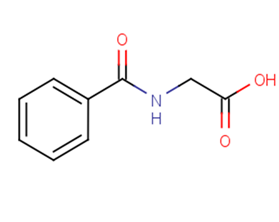
Hippuric acid
CAS No. 495-69-2
Hippuric acid( 2-Benzamidoacetic acid | Benzoylglycine )
Catalog No. M19608 CAS No. 495-69-2
Hippuric acid is an acyl glycine formed by the conjugation of benzoic acid with glycine. Hippuric acid is a normal component of urine and is typically increased with increased consumption of phenolic compounds (tea wine fruit juices).
Purity : >98% (HPLC)
 COA
COA
 Datasheet
Datasheet
 HNMR
HNMR
 HPLC
HPLC
 MSDS
MSDS
 Handing Instructions
Handing Instructions
| Size | Price / USD | Stock | Quantity |
| 500MG | 38 | In Stock |


|
| 1G | Get Quote | In Stock |


|
Biological Information
-
Product NameHippuric acid
-
NoteResearch use only, not for human use.
-
Brief DescriptionHippuric acid is an acyl glycine formed by the conjugation of benzoic acid with glycine. Hippuric acid is a normal component of urine and is typically increased with increased consumption of phenolic compounds (tea wine fruit juices).
-
DescriptionHippuric acid is an acyl glycine formed by the conjugation of benzoic acid with glycine. Hippuric acid is a normal component of urine and is typically increased with increased consumption of phenolic compounds (tea wine fruit juices). These phenols are converted to benzoic acid which is then converted to hippuric acid and excreted in the urine.
-
In Vitro——
-
In Vivo——
-
Synonyms2-Benzamidoacetic acid | Benzoylglycine
-
PathwayOthers
-
TargetOther Targets
-
RecptorOthers
-
Research Area——
-
Indication——
Chemical Information
-
CAS Number495-69-2
-
Formula Weight179.17
-
Molecular FormulaC9H9NO3
-
Purity>98% (HPLC)
-
SolubilityDMSO:10 mM
-
SMILESOC(=O)CNC(=O)c1ccccc1
-
Chemical Name——
Shipping & Storage Information
-
Storage(-20℃)
-
ShippingWith Ice Pack
-
Stability≥ 2 years
Reference
1.Niwa T et al. Organic acids and the uremic syndrome: protein metabolite hypothesis in the progression of chronic renal failure. Semin Nephrol. 1996 May;16(3):167-82.
molnova catalog



related products
-
Octenyl succinic anh...
Octenyl succinic anhydride (OSA) is utilized to esterify starch, producing octenyl succinylated starch (OS-starch), a hydrocolloid with amphiphilic properties.
-
2,3-Diaminonaphthale...
2,3-Diaminonaphthalene is a highly selective fluorometric and colorimetric reagent for selenium detection and also used for the fluorometric determination of nitrite.
-
7-Bromo-2,4-diaminoq...
7-Bromo-2, 4-diaminoquinazoline is an active biochemical.



 Cart
Cart
 sales@molnova.com
sales@molnova.com


